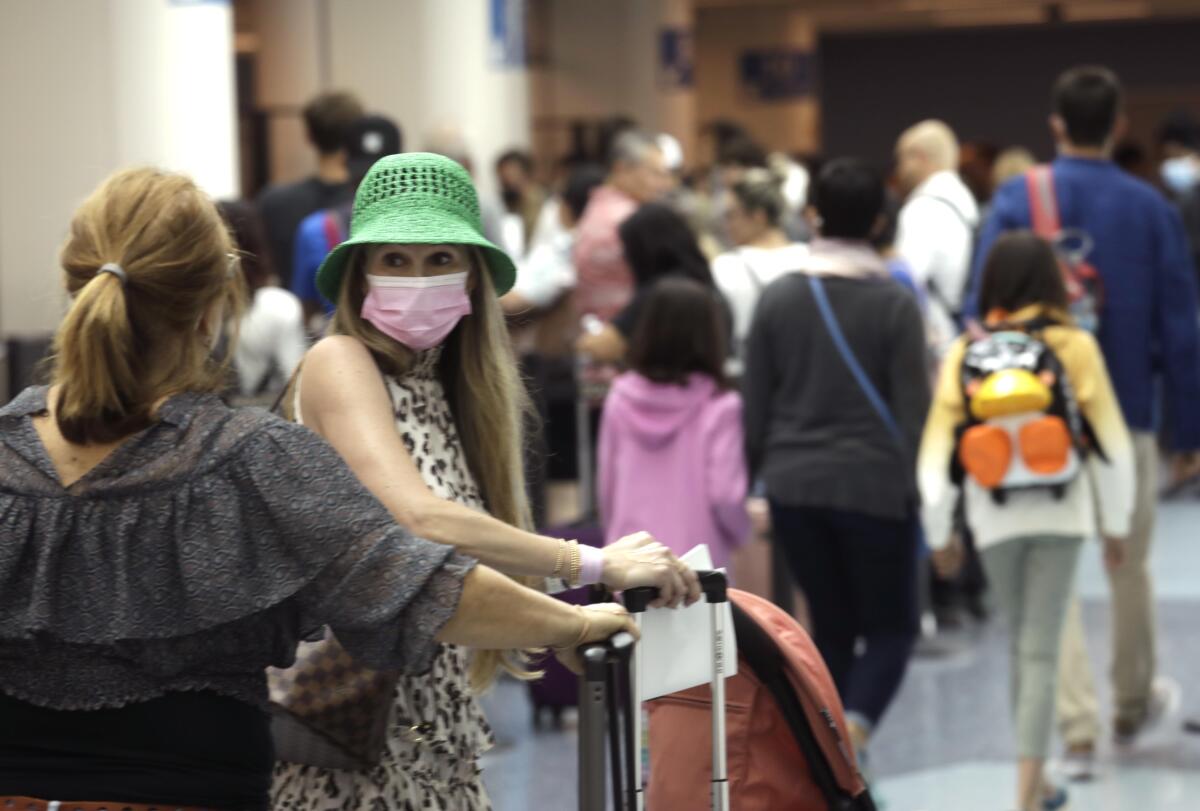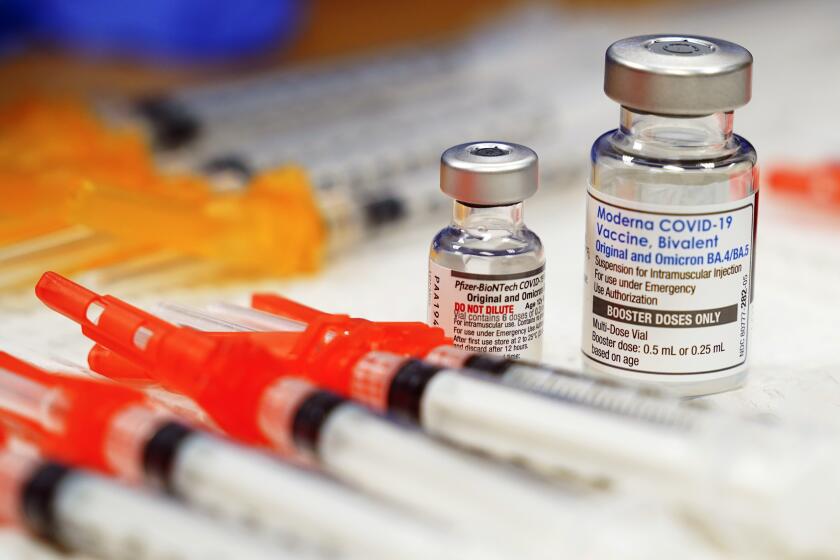COVID deaths were cut nearly in half in 2022, but disease is still a top killer, especially in the South

The national COVID-19 death rate fell by nearly 50% in 2022 compared to the prior year, a decline that has been credited to widespread vaccinations as well as a rise in natural immunity following the first Omicron surge.
There were 244,986 deaths in the U.S. that listed COVID-19 as the underlying or contributing cause, down 47% from 2021 when 462,193 deaths were reported, according to an analysis of provisional death certificate data published Thursday by the U.S. Centers for Disease Control and Prevention. The number excludes residents of U.S. territories and foreign countries.
The early months of 2022 included the second-deadliest surge of COVID-19, as the first Omicron wave sent the extraordinarily contagious variant seemingly everywhere in the U.S. But during the summer and most recent winter, deaths dramatically lessened.
Besides vaccinations and rising natural immunity, 2022 also brought the widespread availability of anti-COVID therapeutic drugs such as Paxlovid, an oral medication that significantly reduces the risk of hospitalization and death when taken by people infected with the coronavirus.
Nonetheless, with nearly a quarter-million fatalities in 2022, COVID-19 has remained a leading cause of death — albeit less so. Last year, COVID-19 deaths were seven times higher than the annual number of flu deaths, which averaged about 35,000 each year in the decade prior to the start of the pandemic.
Nationally, COVID-19 surged to become the third leading cause of death in both 2020 and 2021. Last year, it fell to fourth place, behind heart disease, cancer and unintentional injury (a category that has remained high because of the elevated number of drug overdose deaths).
With the nation’s COVID-19 public health emergency ending and less state cooperation, the CDC has a new plan for monitoring the coronavirus across the U.S.
The COVID-19 death toll — now 1.13 million in the U.S. and 6.9 million worldwide — is staggering, with a national death toll that exceeds the last global pandemic of this scale, although the global tally is far lower. The flu pandemic that began in 1918 resulted in an estimated 675,000 deaths in the U.S. and at least 50 million worldwide.
According to the latest analysis, published by the CDC’s National Center for Health Statistics, COVID-19 deaths were highest in the U.S. for people 85 and older. In 2022, that group’s death rate was triple those ages 75 to 84 and about eight times higher than the youngest seniors, ages 65 to 74.
Men had a 50% higher death rate than women.
Of all fatalities with any mention of COVID-19 on the death certificate, 76% listed COVID-19 as the underlying cause. That’s lower than in 2020 and 2021, when COVID-19 was the underlying cause in 90% of deaths where the illness was mentioned anywhere on the death certificate; the rest listed it as a contributing cause of death.
Among deaths where COVID-19 was listed as a contributing factor, the most frequent main causes of deaths were heart disease, cancer, chronic lower respiratory disease, stroke, Alzheimer’s disease, unintentional injuries, diabetes, kidney disease and Parkinson’s disease.
In 2022, most COVID-19 deaths — 59% of them — occurred in hospitals. An increasing number were occurring at home (15%) or a nursing home or long-term care facility (14%), the report said.
Even in a time of plentiful vaccines and therapeutics, California is still tallying more than 20 COVID-19 deaths every day, on average.
The analysis also calculated death rates by the 10 regions defined by the U.S. Department of Health and Human Services.
For the second consecutive year, the South had the worst COVID-19 death rates. The highest rate in both 2021 and 2022 occurred in the central South region that covers Texas, Louisiana, Oklahoma, Arkansas and New Mexico. In 2022, the rate for that region was 69.3 COVID-19 deaths for every 100,000 residents.
In second place for both years was the Southeast, defined as Florida, Georgia, North Carolina, Tennessee, South Carolina, Alabama, Kentucky and Mississippi. The rate there in 2022 was 65.5 COVID-19 deaths for every 100,000 residents.
Close behind was the Midwest — Illinois, Ohio, Michigan, Indiana, Wisconsin and Minnesota — with a rate of 65.1 COVID-19 deaths for every 100,000 people; and the Mid-Atlantic, which represents Pennsylvania, Virginia, Maryland, West Virginia, Delaware and the District of Columbia, with 64.9 COVID-19 deaths for every 100,000.
In fifth place were the central Great Plains states of Missouri, Iowa, Kansas and Nebraska, with 63.7 COVID-19 deaths per 100,000 residents, ranking just above the national death rate of 61.3 deaths for every 100,000.
Below the national COVID-19 death rate was the New York-New Jersey region, with 57.4 deaths per 100,000 residents. The Southwest, which encompasses California, Arizona, Nevada and Hawaii, had the fourth-lowest rate: 53 COVID-19 deaths per 100,000 residents. The northern Rockies and northern Great Plains states of Colorado, Utah, Montana, South Dakota, North Dakota and Wyoming had a rate of 52.2 COVID-19 deaths per 100,000 residents.
The region with the second-lowest COVID-19 death rate in 2022 was the Northwest — Washington, Oregon, Idaho and Alaska — with a rate of 50.9 deaths per 100,000 residents. New England had the lowest COVID-19 death rate in 2022, of 49.5 deaths per 100,000 residents.
The South didn’t always have the highest COVID-19 death rate nationally. In 2020, the New York-New Jersey region topped that tally, while New England’s death rate was also slightly higher than the national average.
Only three regions had COVID-19 death rates lower than the national average for all three years of the pandemic: the Southwest; the Northwest; and the northern Rockies/northern Great Plains. Conversely, one region had death rates that were higher than the national rate for each of those years: the central South area that encompasses Texas and its neighboring states.
The Biden administration will end the last remaining federal COVID-19 vaccine requirements next week when the national public health emergency for the coronavirus ends.
The magnitude of the disparity of COVID-19 deaths by race and ethnic groups lessened in 2022 compared with the prior year, but still remained for many. In general, disparities by race and ethnic group have been worse during pandemic spikes, and there were fewer surges in 2022.
In 2022, Native Americans had a COVID-19 death rate 42% worse than white residents; for Black residents and Pacific Islanders, the rate was 19% and 11% worse, respectively. Latino COVID-19 death rates were about the same as those for white residents, while Asian American and multiracial groups had rates below that of white residents.
The magnitude of the death disparity was worse in 2021. Compared to white residents, Native American and Pacific Islanders’ COVID-19 death rate was more than 90% higher; Latino death rates were 54% higher; and Black death rates were 44% higher.
In 2020, compared to white residents, Native Americans died of COVID-19 at a rate 157% higher. For Latino residents, the rate was 122% higher; Black residents, 109% higher; and Pacific Islander residents, 67% higher.
COVID-19 death rates fell for all racial and ethnic groups from 2021 to 2022. However, between 2020 and 2021, they grew notably for white residents, jumping 42%. They also increased 59% for multiracial residents and 63% for Pacific Islanders. During that same span, death rates among Latino, Black and Native American residents remained at generally the same, distressingly high levels.
The data published in the CDC analysis is considered provisional and incomplete. Final mortality data for 2022 is expected to be released toward the end of this year.
More to Read
Sign up for Essential California
The most important California stories and recommendations in your inbox every morning.
You may occasionally receive promotional content from the Los Angeles Times.















